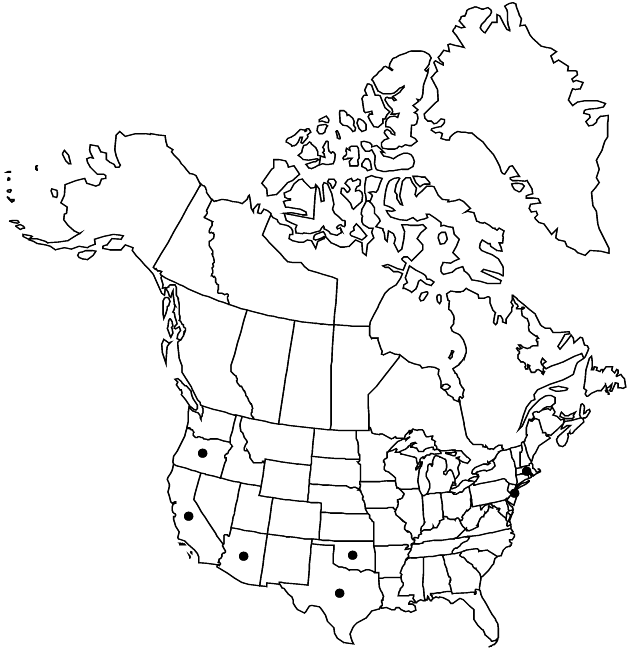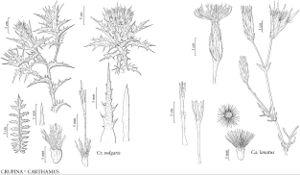Difference between revisions of "Carthamus lanatus"
Sp. Pl. 2: 830. 1753.
FNA>Volume Importer |
FNA>Volume Importer |
||
| Line 24: | Line 24: | ||
|elevation=0–1100 m | |elevation=0–1100 m | ||
|distribution=Ariz.;Calif.;Mass.;N.J.;Okla.;Oreg.;Tex.;Europe. | |distribution=Ariz.;Calif.;Mass.;N.J.;Okla.;Oreg.;Tex.;Europe. | ||
| − | |discussion=<p>Native to the Mediterranean region, Carthamus lanatus is a viciously spiny noxious weed, sometimes forming nearly impenetrable stands. In rangelands it is known to injure the eyes and mouths of livestock, and it tends to spread when more palatable plants are consumed. Because of the close relationship between the cultivated safflower (Carthamus tinctorius) and its weedy relatives, biocontrol has not been an option for controlling weedy species such as C. lanatus.</p> | + | |discussion=<p>Native to the Mediterranean region, <i>Carthamus lanatus</i> is a viciously spiny noxious weed, sometimes forming nearly impenetrable stands. In rangelands it is known to injure the eyes and mouths of livestock, and it tends to spread when more palatable plants are consumed. Because of the close relationship between the cultivated safflower (<i>Carthamus tinctorius</i>) and its weedy relatives, biocontrol has not been an option for controlling weedy species such as <i>C. lanatus</i>.</p> |
|tables= | |tables= | ||
|references= | |references= | ||
| Line 49: | Line 49: | ||
|publication year=1753 | |publication year=1753 | ||
|special status= | |special status= | ||
| − | |source xml=https://jpend@bitbucket.org/aafc-mbb/fna-data-curation.git/src/ | + | |source xml=https://jpend@bitbucket.org/aafc-mbb/fna-data-curation.git/src/8f726806613d60c220dc4493de13607dd3150896/coarse_grained_fna_xml/V19-20-21/V19_202.xml |
|tribe=Asteraceae tribe Cardueae | |tribe=Asteraceae tribe Cardueae | ||
|genus=Carthamus | |genus=Carthamus | ||
Revision as of 15:09, 18 September 2019
Plants 40–180 cm, herbage ± densely glandular, loosely cobwebby to ± woolly. Stems rigidly erect, openly branched distally, stramineous. Leaves basal and cauline; basal often absent at anthesis, petioles winged, blades 10–15 cm, margins pinnately 1–2-divided into linear or lanceolate spine-tipped lobes; cauline spreading or recurved, lanceolate to ovate, rigid, clasping, 3–7-veined from base, margins with narrow spine-tipped lobes, spinose-acuminate. Involucres ovoid, body 25–35 mm, usually ± tomentose. Outer phyllaries ascending or ± spreading, 35–50 mm, usually not more than 1.5 times as long as inner, terminal appendages spreading to ascending, linear-lanceolate, spiny lobed, prominently spine-tipped. Corollas yellow, sometimes red- or black-veined, 25–35 mm, throats gradually expanded; anthers yellow; pollen yellow. Cypselae brown, 4–6 mm, the outer roughened; pappus scales 1–13 mm. 2n = 44.
Phenology: Flowering Apr–Sep(–Nov).
Habitat: Roadsides, grain fields, pastures
Elevation: 0–1100 m
Distribution

Ariz., Calif., Mass., N.J., Okla., Oreg., Tex., Europe.
Discussion
Native to the Mediterranean region, Carthamus lanatus is a viciously spiny noxious weed, sometimes forming nearly impenetrable stands. In rangelands it is known to injure the eyes and mouths of livestock, and it tends to spread when more palatable plants are consumed. Because of the close relationship between the cultivated safflower (Carthamus tinctorius) and its weedy relatives, biocontrol has not been an option for controlling weedy species such as C. lanatus.
Selected References
None.
